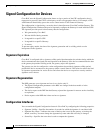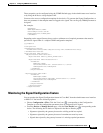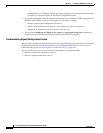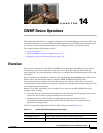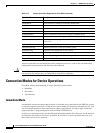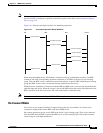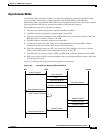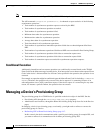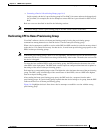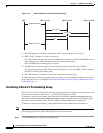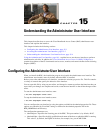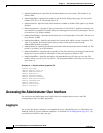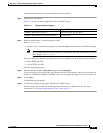
14-6
Cisco Broadband Access Center 3.8 Administrator Guide
OL-27172-01
Chapter 14 CWMP Device Operations
Managing a Device’s Provisioning Group
Note You must use the batch mode flag, ASYNC_AUTOMATIC during the asynchronous operation mode.
The API command
Configuration.getRDUDetails() is enhanced to report statistics of the following
asynchronous operations:
• Total number of asynchronous operation requests received by the RDU.
• Total number of asynchronous operation succeeded.
• Total number of asynchronous operation failed.
• Minimum time taken for asynchronous operation.
• Maximum time taken for asynchronous operation.
• Average time taken for asynchronous operation.
• Total time taken for all asynchronous operations.
• Total number of asynchronous immediate operations failed due to acknowledgment failed from
DPE.
• Total number of asynchronous operations failed due to DPE server not found in Provisioning Group.
• Total number of asynchronous operations failed due to connection request error.
• Total number of asynchronous operations failed due to connection request failed.
• Total number of connection request succeeded for asynchronous operations requests.
Conditional Execution
Additionally, immediate and on-connect operations are conditionally executed based on the TR-069
Event Codes in the Inform message from the device. If no intersection occurs between the reported Event
Codes in the device’s Inform and the list of Event Codes specified in the operation, the operation is not
executed.
For example, an operation might be conditional upon the Inform Event Code list including
6 CONNECTION
REQUEST
. Therefore, the operation only executes if the device reports it is connecting because of an
autoconfiguration server (ACS) connection request. If the device reports it is connecting for any other
reason, for instance a periodic Inform, the operation does not execute.
Managing a Device’s Provisioning Group
The provisioning group for a CWMP device is specified on the device object in the RDU. On the:
• Provisioning API, through the IPDeviceKeys.HOME_PROV_GROUP property.
• Administrator user interface, through the Home Provisioning Group drop-down list in the Devices
pages.
In managing a device’s provisioning group, occasionally, you might need to redirect or correct the
provisioning group of a device:
• Redirecting CPE to Home Provisioning Group, page 14-7.
In this scenario, the device communicates with a specific provisioning group, for example PG1, and
you want to redirect it to communicate with its home provisioning group, PG2.



